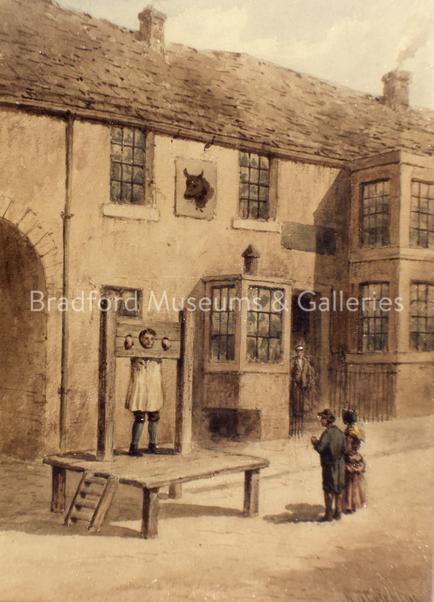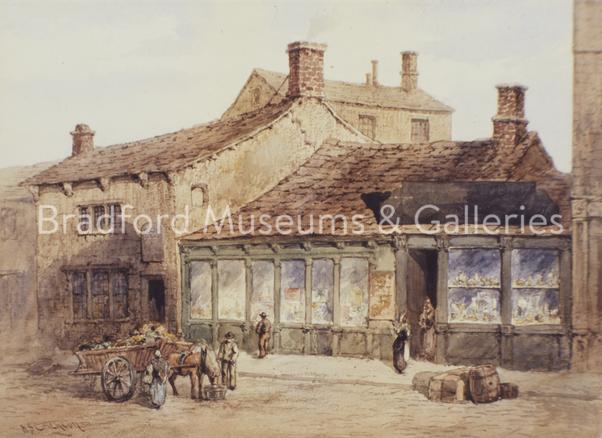Assistant Curator Lauren Padgett shares with us some of our fascinating collection of paintings by N. S. Crichton which have preserved bygone Bradford for posterity. She writes:
In the Bradford Museums and Galleries collection, we have a set of fascinating watercolour paintings of old Bradford. Painted by N. S. Crichton, they give an insight into what Bradford was like in the nineteenth century.
We are indebted to Alfred Megson, a local art dealer and artist, for this unique collection of paintings as it was Megson who commissioned local artist Crichton to paint Bradford buildings and streets during the 1870s and 1880s.
Megson was conscious that some of the older buildings were being demolished to make way for new developments as the Bradford city centre tried to keep up with the increasing population levels and booming business. Megson wanted a record of bygone Bradford for posterity.
Crichton produced over a hundred paintings showing Bradford’s main streets, popular inns and public houses, specific shops, back alleys, grand as well as modest houses, the pillory and key buildings like Bradford Parish Church, Paper Hall and Market House. The attention to detail is extraordinary with the different colours and textures of the stone buildings and pathways. It has been noted that Crichton painted some buildings and structures which were no longer standing at the time he was commissioned to paint, so Crichton must have been relying on his memory as well as information given to him, with a probable pinch of artistic licence.
Megson exhibited the finished paintings at The British Gallery in 1891 and reproduced them as a ‘Bygone Bradford’ series with added information by Arthur North. They were known as Mr Megson’s collection as opposed to Crichton’s paintings. Local printer Alfred Coe produced a series of postcards of ‘Old Bradford’ in late 1902 or early 1903 using the watercolour paintings by Crichton. The original paintings were donated to Bradford Corporation in 1892 and are today looked after by Bradford Museums and Galleries; some of which are on display at Bolling Hall Museum.
Here is an example of some:
Bulls’ Head Inn and pillory
A pillory was near the Bulls’ Head Inn at the bottom of Westgate where the old market was. People were permitted to throw eggs, fruit or potatoes, but not stones, at those in the pillory.
Use of the pillory was outlawed in 1830, decades before Crichton painted it. It is said that the last person who stood in the pillory was a woman from Clayton found guilty of theft.
The Bulls’ Head is thought to have got its name from the bull-baiting that happened outside of it – this was outlawed in 1835. The Inn was used to conduct political and business meetings as well as hold judicial sessions before Bradford got an official courthouse in 1834. The Bulls’ Head Inn ceased trading by 1886.
Bradford Parish Church
St. Peter’s Church was the Bradford Parish Church until it became Bradford Cathedral in 1919. The oldest parts of the church date to the 15th century with a church being on that site since the Anglo-Saxon period.
The construction of buildings nearby in the mid to late nineteenth century, such as the looming Post Office building (now St Peter’s House) in front of it, obscures the Church from the town centre but prior to that it was a domineering presence overlooking the Bradford town centre on its outskirts .
Judy Barrett’s Sweet Shop
Judy Barrett, known as Old Judy, was born in 1777 and took over her father’s green grocer business in Westgate around 1810 after his death.
Judy was famous for her humbugs which were mint flavoured brown hard boiled sweets with a toffee centre.
Judy was a familiar Bradford character often seen wearing a man’s coat with her donkey pulling a cart from the town centre to Low Moor to collect coal which she carried back on the cart and in a sack on her back. She died in 1860 before Crichton was given the painting commission.



2 Responses
I am looking for the location of the N S Crichton’s water colour painting of the canal basin in Bradford.
Hello Graham,
Thanks for your message. We do have a large collection of Crichton’s work. My initial check hasn’t shown that particular image is one of them. However if you do come across any other references that suggest it should be, please can you get in touch with the collections team.